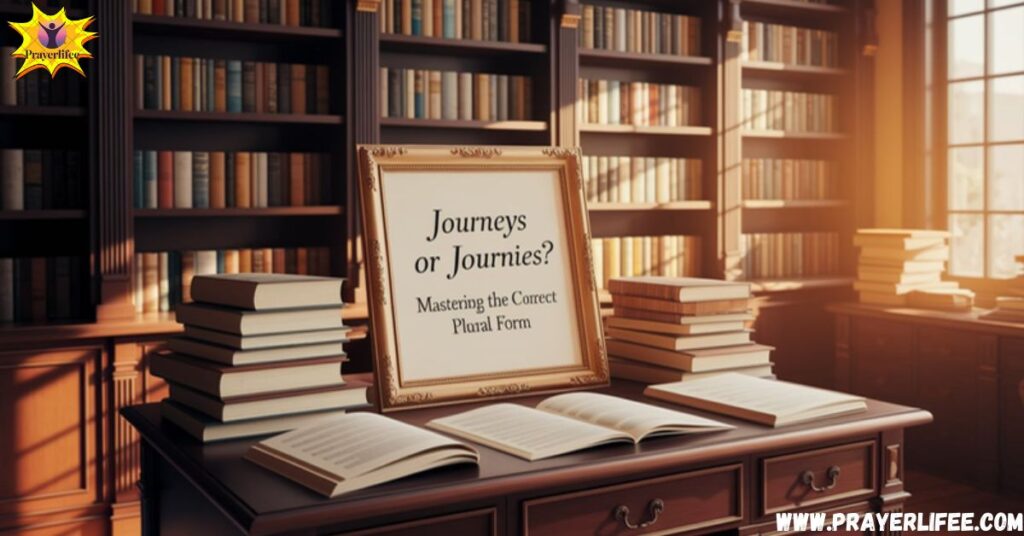English grammar can sometimes be tricky, especially when it comes to plural nouns. The rules governing pluralization seem to follow patterns, but there are always exceptions. A common mistake that confuses many English learners is how to correctly pluralize words that end in y. A prime example is the word journey. Should the plural be journeys or journies? If you’re unsure, don’t worry—you’re not alone.
We will break down the rules that govern pluralization, focusing on why the correct form is journeys and why journies is a spelling mistake. We will also cover essential grammar rules for plurals, how to avoid similar errors in other words, and provide real-life examples of how to use journeys correctly. Let’s get started with mastering the plural form of journey and avoiding common grammar mistakes.
The Plural Form of “Journey”
To understand how to correctly pluralize journey, we first need to look at what the word means. A journey refers to a trip, voyage, or process of traveling from one place to another. It can be used in both literal and metaphorical contexts. For instance:
- Literal journey: “We took a long journey through the mountains.”
- Metaphorical journey: “Her career has been a journey of growth and development.”
- In the singular form, the word is simply “journey.” When we want to talk about more than one, we follow a specific set of rules for creating plural nouns. Journeys is the correct plural form, and here’s why.
Why “Journies” is Incorrect

One of the most common mistakes people make is using the plural form journies instead of journeys. This confusion often stems from a misunderstanding of English spelling patterns—specifically how to form the plural of words that end in y.
In English, there are different rules for pluralizing nouns that end in y. If the word ends with a vowel (such as a, e, i, o, u) before y, you simply add an s to form the plural. This is the case with journey, which ends in ey (a vowel before y). Therefore, the correct plural is journeys.
The mistake of using journies arises from applying the rule used for words that end in a consonant before y. When a noun ends in a consonant + y, you change the y to ies and add it to the plural form. For example:
- City becomes cities.
- Party becomes parties.
- Baby becomes babies.
However, since journey does not end in a consonant + y, the rule does not apply here. Therefore, the correct plural is journeys.
The Vowel Before Y Rule
The Vowel Before Y Rule is one of the key rules governing how to form the plural of words that end in y. According to this rule, if a word ends in a vowel followed by y, you simply add an s to the end of the word to form the plural. Let’s take a closer look at a few examples to illustrate this:
| Singular | Plural | Rule |
| Key | Keys | Vowel + Y |
| Monkey | Monkeys | Vowel + Y |
| Journey | Journeys | Vowel + Y |
| Valley | Valleys | Vowel + Y |
As you can see, when a noun ends with a vowel before y, like in the case of journey, we simply add an s to make it plural. Journeys is the correct plural form in this case.
The Consonant Before Y Rule
On the other hand, when a noun ends in a consonant followed by y, the rule changes. In this case, you change the y to ies to form the plural. This rule applies to words like city, party, and baby. Let’s take a look at some examples:
| Singular | Plural | Rule |
| City | Cities | Consonant + Y |
| Party | Parties | Consonant + Y |
| Baby | Babies | Consonant + Y |
| Story | Stories | Consonant + Y |
These examples follow the Consonant Before Y Rule, where you change the y to ies because the word ends with a consonant before y. Since journey does not fit this pattern, it stays as journeys when pluralized.
Read More: Journeys or Journies? Mastering the Correct Plural Form
Key Examples for Comparison
To make things clearer, let’s look at a table that compares words ending in a vowel before y with words ending in a consonant before y:
| Vowel Before Y (Add “s”) | Consonant Before Y (Change to “ies”) |
| Monkey → Monkeys | City → Cities |
| Key → Keys | Party → Parties |
| Journey → Journeys | Baby → Babies |
| Valley → Valleys | Story → Stories |
This table summarizes the two main rules for pluralizing words that end in y and demonstrates why journeys is the correct plural form for journey.
Literal and Metaphorical Journeys

Now that we know the correct plural form is journeys, let’s explore how the word journey is used in both literal and metaphorical contexts. The plural form journeys applies in both cases.
Literal Journeys
A literal journey refers to actual physical travel from one place to another. For example, traveling on a bus, going on vacation, or crossing the country are all examples of literal journeys. Here’s how you might use journeys in this context:
- “Their journeys through the mountains were filled with breathtaking views.”
- “The journeys of the explorers were recorded in history books.”
- In these sentences, journeys refers to the physical travel undertaken by people.
Metaphorical Journeys
On the other hand, a metaphorical journey refers to personal growth, emotional transformation, or any kind of progress that is not physical. For example, someone’s career progression or spiritual development can be described as a metaphorical journey. Here’s an example:
- “Her career journeys have taken her to many different countries and fields.”
- “The novel explores the emotional journeys of its characters as they struggle with personal challenges.”
- In these sentences, journeys refers to the non-physical experiences that shape people’s lives.
Common Grammar Mistakes in Plural Forms
One of the most common grammar mistakes is incorrectly forming the plural of words that end in y. For example, people may mistakenly write journies instead of journeys. This mistake happens because many people assume that all words ending in y follow the same rule, but as we’ve seen, the Vowel Before Y Rule and Consonant Before Y Rule must be carefully considered.
Here are a few other common mistakes related to pluralization:
| Incorrect | Correct | Reason |
| Valeys | Valleys | Follows Vowel Before Y Rule |
| Babys | Babies | Follows Consonant Before Y Rule |
| Knifes | Knives | Irregular form—change “fe” to “ves” |
| Boxs | Boxes | Add “es” to words ending in “x” |
As you can see, pluralization mistakes can take many forms, but they all stem from misunderstanding how to apply the basic rules. Once you familiarize yourself with these rules, you’ll make fewer grammar errors in your writing.
How to Avoid These Mistakes
To avoid common grammar mistakes like using journies instead of journeys, here are a few tips:
- Learn the rules: Understanding when to add s and when to change y to ies will help you avoid common spelling mistakes.
- Use grammar-checking tools: Tools like Grammarly or Microsoft Word’s spell check can flag errors and help you spot mistakes in real time.
- Practice: The more you practice writing, the easier it will become to remember the rules of pluralization.
- Consult reliable resources: If you’re ever unsure, check an online dictionary or grammar guide to confirm the correct form.
Real-Life Examples of “Journeys” in Writing

Using the correct plural form of journey is important in both professional and creative writing. Let’s look at a few examples of how journeys might be used in different contexts:
Career Journeys
In professional writing, you might use the word journeys to describe someone’s career progression. For example:
- “His journeys through the business world have shaped his leadership skills.”
Here, journeys refers to the different steps or experiences in a person’s career, which are not physical but are part of their professional development.
Spiritual Journeys
In spiritual or religious contexts, people often talk about journeys as paths to self-discovery or enlightenment. For example:
- “The monk’s journeys through different spiritual practices led to a deep understanding of life.”
This example shows that journeys can also be used to describe personal or metaphorical journeys that aren’t based on physical travel.
Emotional Journeys
In literature and personal narratives, journeys is often used to describe the emotional development or transformation of a character. For example:
- “The novel follows the journeys of its characters as they confront their darkest fears.”
Here, the journeys are not physical travel but emotional growth, which is why the plural form journeys is correct.
Practical Usage Tip
Whenever you write, it’s important to double-check the plural form of words like journey that end in y. If you’re ever unsure, remember the basic rules: if the word ends with a vowel + y, add s to make it plural. If it ends with a consonant + y, change the y to ies.
Additionally, tools like Grammarly or spell-check can catch spelling mistakes related to pluralization, helping you avoid embarrassing errors.
Conclusion
The correct plural form of the word journey is journeys, not journies. By understanding the Vowel Before Y Rule and Consonant Before Y Rule, you can avoid this common spelling mistake and improve your writing clarity. Remember, accuracy in pluralization not only helps you avoid grammar mistakes but also makes your writing appear more professional and polished.
Now that you understand the rules and have examples to guide you, take the time to apply them in your writing. Whether you’re writing about literal journeys or metaphorical journeys, using the correct plural form will help you communicate your ideas more clearly. So, let’s leave the confusion behind and confidently use journeys to refer to more than one of these fascinating trips, whether they are physical or emotional.

